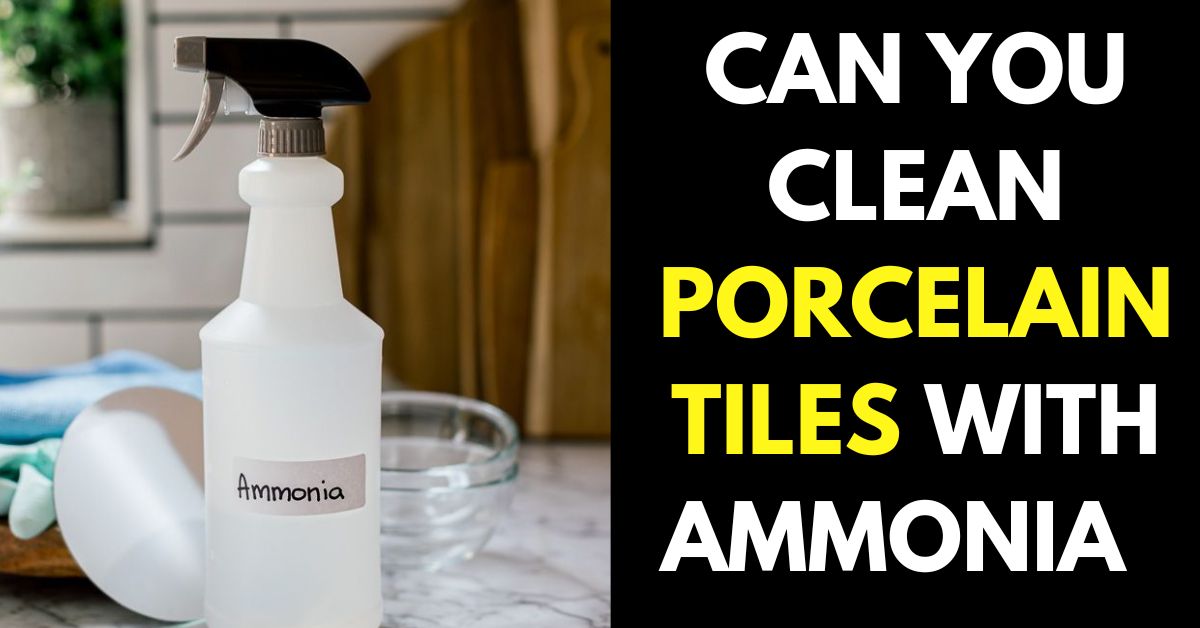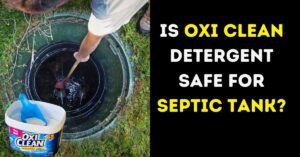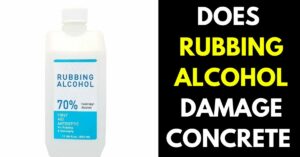
Porcelain tiles are a popular flooring option in many homes and businesses due to their durability and easy maintenance. However, over time, dirt and grime can accumulate on the surface of these tiles, making them look dull and unappealing. One common question that arises when it comes to cleaning porcelain tiles is whether or not ammonia can be used. Ammonia is a powerful cleaning agent that is commonly found in many household cleaners, but is it safe and effective for cleaning porcelain tiles?
In this article, we will explore the pros and cons of using ammonia to clean porcelain tiles and provide some alternative cleaning methods to keep your floors looking their best.

Can You Clean Porcelain Tile with Ammonia
While ammonia can be an effective cleaner for many surfaces, it’s not recommended for cleaning porcelain tile. Ammonia is an alkaline substance and can potentially damage the finish or glaze on porcelain tiles, leaving them looking dull and fading over time.
Instead, it’s best to use a mild, pH-neutral cleaner specifically designed for porcelain tile.
Always follow the manufacturer’s instructions on the cleaner and test it on a small, inconspicuous area before using it on the entire floor. This will ensure that the cleaner doesn’t damage or discolor your porcelain tile.
It’s also important to avoid using abrasive scrubbers or tools that could scratch the surface of the tile, as this can create a porous surface that’s more prone to staining and damage. Instead, use a soft-bristled brush or mop to gently scrub away any dirt or grime on the surface of the tile.
Is It Ok to Use Ammonia on Tile Floors?
It is generally safe to use ammonia on tile floors, but it’s important to take some precautions and use it properly to avoid any damage or harm.
Ammonia is a powerful cleaning agent that can effectively remove dirt and grime from tile floors. However, it is also highly alkaline and can damage certain types of tile and grout if used in excessive amounts or left on for too long.
Does Ammonia Damage Tiles?
Ammonia can potentially damage certain types of tiles if it is not used properly.
Ammonia is a strong alkaline cleaning agent that can be effective in removing tough stains and grime on surfaces, including tiles. However, some tiles are more sensitive to alkaline solutions and can be damaged by prolonged exposure to ammonia.
What Is the Best Way to Clean Porcelain Tile Floors?

The best way to clean porcelain tile floors is by using a combination of regular sweeping and damp mopping with a pH-neutral cleaner. Here are the steps to follow:
- Sweep or vacuum the floor: Before you start cleaning, remove any loose debris or dust from the floor using a broom or vacuum cleaner. This will prevent any dirt from scratching the surface of the tiles during cleaning.
- Prepare a cleaning solution: Mix a small amount of pH-neutral cleaner with warm water in a bucket. Avoid using acidic or abrasive cleaners as they can damage the porcelain tiles.
- Mop the floor: Dip a mop into the cleaning solution and wring it out so it’s not too wet. Begin mopping the floor in sections, starting from the farthest corner of the room and working your way toward the door. Rinse the mop frequently and change the cleaning solution when it becomes dirty.
- Rinse the floor: After you’ve finished mopping, rinse the floor thoroughly with clean water to remove any residual cleaning solution. This will prevent any residue from building up on the surface of the tiles.
- Dry the floor: Use a clean, dry mop or towel to remove any excess water from the floor. This will prevent any water spots or streaks from forming on the tiles.
- Optional: Apply a sealer: If your porcelain tiles are unglazed or have a matte finish, you may want to consider applying a sealer after cleaning to protect them from stains and dirt. Follow the manufacturer’s instructions for application.
What Cleans Better Ammonia or Vinegar?

Whether ammonia or vinegar cleans better depends on the specific cleaning task and the type of surface being cleaned.
Ammonia is a powerful cleaning agent that is effective at cutting through grease and grime on hard surfaces such as glass, tile, and metal. It is also effective at removing stains and odors from carpets and upholstery. However, it can be harsh and corrosive, and it can cause damage to some surfaces if not used properly.
Vinegar, on the other hand, is a mild acid that is effective at cleaning and disinfecting surfaces. It is particularly useful for cleaning windows, mirrors, and other glass surfaces, as it leaves a streak-free finish. It is also a good choice for cleaning floors, countertops, and other surfaces that are not sensitive to acid.
In general, vinegar is a safer and more versatile cleaning agent than ammonia. It is non-toxic, biodegradable, and inexpensive, making it a popular choice for eco-friendly cleaning. However, for tougher cleaning tasks, such as removing heavy grease or grime, ammonia may be a more effective option.
What Is the Best Way to Clean Porcelain Tile in a Shower
Cleaning porcelain tile in a shower requires some specific steps to ensure that the tiles are properly cleaned and sanitized.
- Remove any loose debris: Before cleaning, remove any loose debris, such as hair or soap scum, from the surface of the tiles and grout using a soft-bristled brush or a sponge.
- Apply a cleaning solution: Spray a pH-neutral or mildly acidic tile and grout cleaner onto the surface of the tiles and grout. Be sure to follow the manufacturer’s instructions for dilution and application.
- Scrub the tiles and grout: Use a soft-bristled brush or a sponge to gently scrub the surface of the tiles and grout, paying particular attention to areas where mildew or soap scum has accumulated.
- Rinse the tiles and grout: Rinse the tiles and grout with warm water to remove the cleaning solution and any debris that has been dislodged.
- Dry the tiles: Use a clean towel or a squeegee to dry the surface of the tiles and prevent water spots or streaks.
- Apply a sealer (optional): If your porcelain tiles are unglazed or have a matte finish, you may want to consider applying a sealer after cleaning to protect them from stains and water damage. Be sure to follow the manufacturer’s instructions for application.
How to Clean Porcelain Tile After Installation
Cleaning porcelain tile after installation is an important step in ensuring that the tiles are properly prepared for use and will last a long time.
- Remove any residual grout: After the grout has dried, use a damp sponge or cloth to remove any residual grout or haze from the surface of the tiles. Be sure to rinse the sponge or cloth frequently to avoid spreading grout around.
- Sweep or vacuum the floor: Before cleaning, remove any loose debris or dust from the floor using a broom or vacuum cleaner. This will prevent any dirt from scratching the surface of the tiles during cleaning.
- Prepare a cleaning solution: Mix a small amount of pH-neutral cleaner with warm water in a bucket. Avoid using acidic or abrasive cleaners as they can damage the porcelain tiles.
- Mop the floor: Dip a mop into the cleaning solution and wring it out so it’s not too wet. Begin mopping the floor in sections, starting from the farthest corner of the room and working your way toward the door. Rinse the mop frequently and change the cleaning solution when it becomes dirty.
- Rinse the floor: After you’ve finished mopping, rinse the floor thoroughly with clean water to remove any residual cleaning solution. This will prevent any residue from building up on the surface of the tiles.
- Dry the floor: Use a clean, dry mop or towel to remove any excess water from the floor. This will prevent any water spots or streaks from forming on the tiles.







